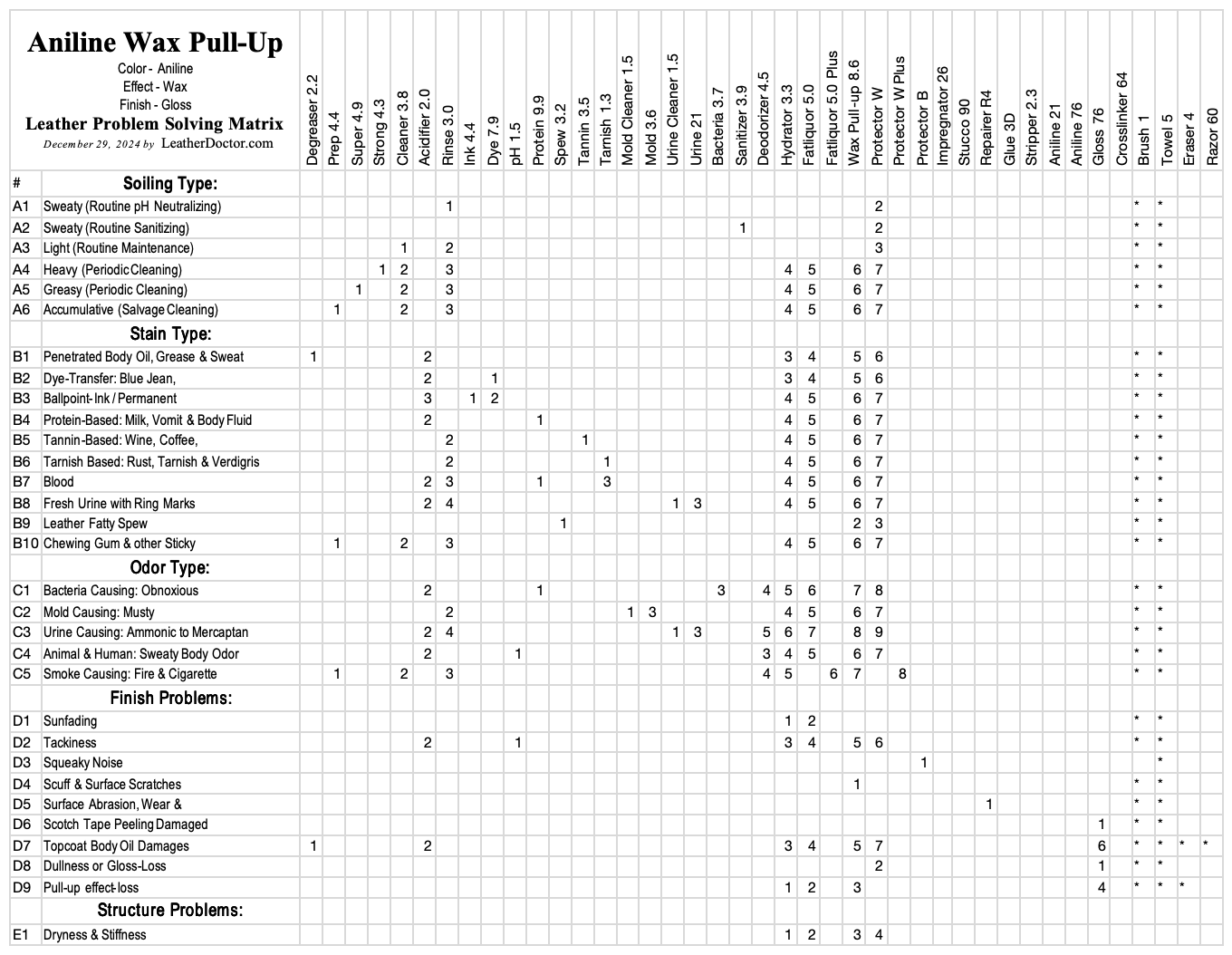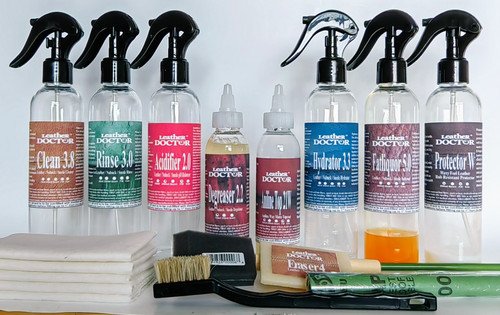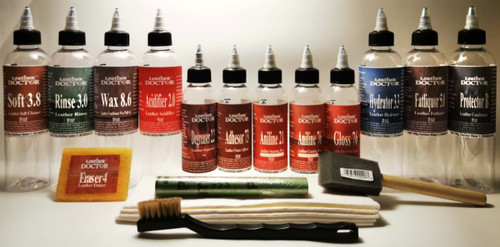Restoration Hardware Wax Pull-Up Leather Topcoat Refinishing Kit RW6.tc by Leather Doctor is a holistic gloss topcoat refinishing system for Aniline Wax Pull-Up.
Wax Pull-Up Leather has a secondary fashion effect derived from Wax Pull-Up 8.6, which creates a lighter appearance when the leather is pulled or scratched. This effect is in addition to the primary softening conditioner, Fatliquor 5.0, which all leathers require to maintain softness and strength. Popular leather furniture brands like Lancaster, Maxwell, and Brompton from Restoration Hardware are well-known examples of wax pull-up leathers.
Wax pull-up leathers can be identified by their unique characteristic—a stretch or pull reveals a lighter color that reverts when released or when heat is applied by rubbing with the hand. However, this pull-up effect fades over time as the wax conditioner dries or the leather ages. The reverse suede of this aniline-dyed-through leather takes on the same color as the surface, which typically has a glossy sheen.
Common topcoat damages occur in high-contact areas like the headrest and armrest, where body oil, grease, and sweat lead to darkening and deterioration. Other common issues include damaging spills, alkaline cleaning product exposure, and physical damage such as cat and dog scratches, abrasions, shoe scuffs, and accidental marks. While physical damages require standard refinishing, soiling, spills, and toxic pH exposure necessitate a more detailed decontaminating process to restore the leather to its healthy state before refinishing.
Kit RW6.tc concentrates require 1856g or 2 quarts distilled water to be mixed and added to 1.5 inches below the top of the 8oz bottles before use. Products are handpicked to perform the following dovetailing sequence of steps to achieve the desired holistic result.
Degreasing & Acidifying system
Degreaser 2.2 is a pH 2.2 water-based degreaser designed to remove penetrated oil, grease, and sweat stains caused by skin and hair contact. It effectively controls tackiness and dye bleeding, ensuring the leather remains stable during the cleaning process. Unlike solvent-based degreasers, Degreaser 2.2 enhances the leather's structural integrity by charging the leather’s protein fibers ionic positive (+ve). This strengthens the ionic attraction between the ionic negative (-ve) tanning agent, dyestuff, and fatliquor, minimizing potential side effects and preserving the leather’s natural properties.
Acidifier 2.0 is a pH 2.0 acidifier rinse designed to control, neutralize, and pH-balance leather chemistry, preventing tackiness and dye bleeding. It works in sequence with Degreaser 2.2, effectively rinsing and rebalancing the leather’s pH. By charging the leather’s protein fibers ionic positive (+ve), it strengthens the ionic attraction between the ionic negative (-ve) leather constituents, such as the tanning agent, dyestuff, and fatliquor. This process ensures leather stability, preventing issues like tackiness, dye loss, and stiffness, while maintaining its natural integrity.
Cleaning & Rinsing system
Cleaner 3.8 is a leather-safe, pH 3.8 mild cleaner designed to effectively emulsify and suspend general soiling without causing common side effects. It is used after Degreaser 2.2 and Acidifier 2.0, ensuring thorough cleaning while extending across the entire section without leaving a dry edge. Its holistic cleaning and rinsing sequence, when followed with Rinse 3.0, restores leather to its natural pH chemistry integrity, preventing issues such as rings and browning, especially on pH-sensitive aniline leathers.
Rinse 3.0 is a pH 3.0 solution designed to remove suspended soil and reinforce the leather's pH integrity. This rinse neutralizes alkaline residues, extracts soiling with towels, and restores the ionic balance (+ve), enhancing tanning agents, dyestuff, and fat liquor bonding to prevent tackiness, bleeding, and stiffness.
Hydrating & Fatliquoring system
Hydrator 3.3 is a pH 3.3 hydrating conditioner formulated to maintain the natural pH integrity of leather while relaxing and softening stiff fibers. It effectively smooths out creases and wrinkles before the fatliquoring process, ensuring the leather remains pliable and breathable. This non-sticky, residue-free solution facilitates colloidal water movement, helping to reactivate dormant dyestuff and allowing the color to resurface for a more even and uniform appearance. Hydrator 3.3 is suitable for all leather types, including vachetta, aniline, nubuck, and full-grain leathers. It plays a crucial role in plumping up the leather, reducing surface interfacial tension, and preparing it for the replenishment of essential fats and oils with Fatliquor 5.0. By using Hydrator 3.3 before fatliquoring, leather is restored to its natural softness, flexibility, and long-term durability.
Fatliquor 5.0 is a pH 5.0 micro-emulsion of fat, oil, and water designed to restore the original softness, strength, and flexibility of leather. It plays a crucial role in the leather’s conditioning process by replenishing the fat and oil content that keeps leather supple and prevents stiffness or cracking. When applied, the water-encased fat and oil molecules penetrate the leather fibers. As the water gradually wicks away during the drying process, the fat and oil remain, hydrogen bond with the fibers and creating a breathable structure that enhances the leather’s elasticity and durability. Fatliquor 5.0 is essential for maintaining and restoring vachetta, aniline, nubuck, suede, and other leathers, preventing them from becoming brittle over time. Proper fatliquoring ensures that leather retains its tensile strength, resists breakage, and continues to feel soft and luxurious.
Wax Pull-up Effect system
Leather Conditioner Wax Pull-up 8.6
Wax Pull-Up 8.6 rejuvenates and restores the diminishing aniline wax effect lost through usage, aging, or cleaning. It enhances the leather’s natural pull-up characteristics by replenishing the wax content that gives the leather its distinctive distressed look. For optimal results, it is highly recommended that the primary leather softening process—hydration with Hydrator 3.3 and fatliquoring with Fatliquor 5.0—be completed before applying Wax Pull-Up 8.6. This ensures that the leather remains soft, flexible, and well-nourished before the wax effect is restored, maintaining both its aesthetic appeal and structural integrity.
Top Coat system
Aniline Gloss Finish Topcoat 76.
Gloss 76 is a heavy-duty, water-based topcoat designed to seal and protect aniline, and wax pull-up leathers with excellent toughness and flexibility. Formulated with a fine particulate urethane-resin emulsion, it provides a clear, glossy finish ideal for upholstery, bags, garments, and saddlery. For enhanced water resistance and to rectify existing finish tackiness, Crosslinker 64 can be added at a 1:95 weight ratio, ensuring a durable and long-lasting protective layer.
Conditioning system
Leather Protector B is a pH 3.0 non-stick, rub-resistant conditioner designed to enhance smooth leather’s durability while providing a soft buttery feel. It increases wet and dry rub resistance, reducing stretch, scuffing, and wear while also cutting friction noise for a smoother, quieter touch. Its non-stick shield prevents sticky soiling from embedding into the leather, while its protective barrier helps resist ballpoint ink transfer and makes dye stains easier to remove. Additionally, it maintains the leather’s natural breathability while offering long-lasting protection. Protector B Plus provides the same benefits as Protector B but with an added luxurious leather scent. It is particularly ideal for pastel-colored leathers, helping to keep them cleaner and stain-free for longer.
Tools
Brush 1 is a detailing horsehair brush for all smooth leather for soft and scratch-free cleaning. Brush 1 is ergonomically designed as an extension of our hand with a sturdy grooved grip to produce effective results easily and efficiently. Its length is 7 inches with a three-row horsehair 1½ inches cleaning head.
Foam 2 is a 2-inch high-density poly foam brush that resists tearing and shredding and carries more material for controlling and spreading solution for a more even distribution.
This paper towel works like cloth and is lint-free, highly absorbent, stretchable, washable, and strong.
Leather Eraser 4 by Leather Doctor is used on all leather, nubuck, and fine suede for dry and wet cleaning with better greasy and gummy soil traction.
Sandpaper 2000 grit is recommended to remove refinishing streaks for in between coatings.
Instruction:
1 Degreasing
- Degreaser 2.2 is shaken to gel before use.
- It is transferred onto Foam 2, Brush 2, or Eraser 4 for better control before applying to the stain.
- It is brushed and suspended soiling extracted with a white absorbent towel changing folding sides until it shows clean, ready for acidifing rinse.
2 Acidifying
- Acidifier 2.0 concentrate 1: 25 is to be mixed with 218g distilled water or 1.5 inches from the top of the 8oz bottle before use.
- It is applied directly, brushed, and extracted with a towel until clean.
- It is kept for 3 to 30 minutes to neutralize and stabilize leather pH.
- Treatment is complete with a test for a healthy squeaky feel, ready for other processes.
Cleaning
- Cleaner 3.8 concentrate 1: 64 is mixed with 224g distilled water or 1.5 inches from the top of the 8oz bottle before use.
- It is applied and brushed with a horsehair Brush 1.
- Suspended soiling is extracted with a dry absorbent towel until it shows clean and proceed to rinse with Rinse 3.0
Rinsing
- Rinse 3.0 concentrate 1: 80 is mixed with 224g distilled water or 1.5 inches from the top of the 8oz bottle before use.
- Rinse 3.0 is applied, brushed, and suspended soiling is extracted with a dry absorbent towel and ready with hydrating.
Hydrating
- Hydrator 3.3 concentrate 1: 25 is mixed with 218g distilled water or 1.5 inches from the top of the 8oz bottle before use.
- Hydrator 3.3 is applied and brushed with a deep even saturating appearance, massaged, and stretched to dimension, before proceeding with fatliquoring.
- Fatliquor 5.0 concentrate 1: 5 requires 189g of distilled water or mixing up to 1.5 inches below the 8oz bottle top before ready to use.
- It is applied and redistributed following the same success technique as Hydrator 3.3.
- Its application is repeated each cycle water contents evaporates.
- Its application ends when the leather absorbs no more and is left to natural drying.
- Its dried sticky residue is rinsed off with Hydrator 3.3.
- Fat-liquored leather is left to dry naturally for extra softness.
- Fat-liquored leather is further staked, massaged, or flexed accordingly with a little wet back with Hydrator 3.3 until dry for extra suppleness.
Wax Effect Conditioning
- Wax Pull-up 8.6, concentrate 1: 9 is mixed with 204g distilled water or 1.5 inches from the top of the 8oz bottle before use.
- It is applied and spread to saturate sufficiently with a horsehair brush evenly to produce a darkening effect.
- It is allowed up to 8 hours of natural drying time or until crystalline is apparent.
- Its crystalline wax is activated with a heat blower or hairdryer to a natural gloss, Gloss 76 is an option for extra gloss.
- Gloss 76 concentrate 1: 2 has to be mixed with 76g of distilled water into the 4oz or 152g into the 8oz bottle before use.
- Use lint-free padding, foam, varnishing brush, or airbrushing for a professional result.
- Blow dry in between applications.
Conditioning
- Conditioner B concentrate 1:15 is mixed with 212g distilled water or 1.5 inches from the top of the 8oz bottle before use.
- It is applied, spread with a brush or a folded towel, is left to dry, and ready to use.
People Also Ask:
- How to Identify Leather Stains?
- How do you use the Aniline Wax Pull-up Leather Problem Matrix?
- Technical Help and Support?
1 How to Identify Leather Stains?

2 How to Use Aniline Wax Pull-up Leather Problem Solving Matrix?
This matrix categorizes common issues with aniline leather into five groups: Soil, Stain, Odor, Structure, and Finish (listed in the left column). Corresponding recommended products are displayed across the top row. Each number within the matrix indicates the steps required to address the problem holistically.
For example:
If a leather issue involves an unknown compound that combines soil, stain, and odor, follow the sequence across the matrix, combining necessary steps from each category. The process should always conclude with
- Hydrator 3.3 to rehydrate and relax the leather.
- Fatliquor 5.0 to replenish lost fats and oils, restoring suppleness.
- Protector B conditioning the leather for ongoing durability.
3 Technical Help and Support?
Your opinions and insights are precious and will help us solve your leather problem more efficiently.
Updated March 11, 2025, by Roger Koh.


















